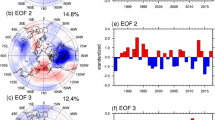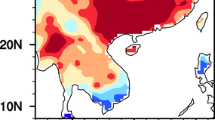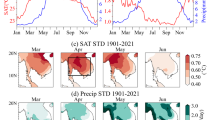Abstract
This study analyzes the dominant modes of interannual variability of surface air temperature (SAT) during boreal autumn over the mid-high latitudes of Eurasia and investigates their associations with snow cover, atmospheric circulation and sea surface temperature (SST). The first, second and third empirical orthogonal function (EOF) mode of autumn SAT anomalies displays same-sign distribution, an east–west dipole pattern and a south–north dipole pattern, respectively. Analysis of surface heat fluxes indicates that snow changes explain only small patches of SAT anomalies related to the first two EOFs via altering surface shortwave radiation. Atmospheric circulation anomalies have important contributions to the formation of SAT anomalies. Southerly (northerly) wind anomalies generally favor positive (negative) SAT anomalies via bringing warmer (colder) air from lower (higher) latitudes. The atmospheric circulation anomalies related to the first EOF mode are attributed to a combination of the Arctic Oscillation (AO) and the Scandinavia pattern and those related to the second EOF mode have a close relation with the East Atlantic/West Russian (EAWR) and circumglobal teleconnection (CGT) patterns. Formation of the atmospheric circulation anomalies related to the third EOF mode is partly related to the Arctic sea ice change around the Barents–Kara Seas. SST anomalies have little contribution to the atmospheric circulation anomalies associated with the first three EOF modes of Eurasian autumn SAT interannual variations. Hindcast skill of the SAT anomalies related to the first (second) EOF mode is improved when taking both the AO and Scandinavia (EAWR and CGT) patterns into account.
















Similar content being viewed by others
References
Barnett T, Dümenil L, Schlese U, Roeckner E, Latif M (1989) The effect of Eurasian snow cover on regional and global climate variations. J Atmos Sci 46:661–686, https://doi.org/10.1175/1520-0469(1989)046,0661:TEOESC.2.0.CO;2
Barnston AG, Livezey RE (1987) Classification, seasonality and persistence of low-frequency atmospheric circulation patterns. Mon Wea Rev 115:1083–1126
Barriopedro D, Fischer EM, Luterbacher J, Trigo RM, Garcı´a-Herrera R (2011) The hot summer of 2010: redrawing the temperature record map of Europe. Science 332:220–224. https://doi.org/10.1126/science.1201224
Brodzik M, Armstrong R (2013) Northern Hemisphere EASE-Grid 2.0 weekly snow cover and sea ice extent, version 4. National Snow and Ice Data Center, Boulder, CO, digital media. [Available online at http://nsidc.org/data/nsidc-0046.]
Caloiero T (2017) Trend of monthly temperature and daily extreme temperature during 1951–2012 in New Zealand. Theor Appl Climatol 129:111–127
Chen S, Song L (2018) The leading interannual variability modes of winter surface air temperature over Southeast Asia. Clim Dyn. https://doi.org/10.1007/s00382-018-4406-x
Chen S, Wu R (2018) Impacts of early autumn arctic sea ice concentration on subsequent spring Eurasian surface air temperature variations. Clim Dyn 51:2523–2542. https://doi.org/10.1007/s00382-017-4026-x
Chen Z, Wu R, Chen W (2014) Impacts of autumn arctic sea ice concentration changes on the East Asian winter monsoon variability. J Clim 27:5433–5450. https://doi.org/10.1175/JCLI-D-13-00731.1
Chen W, Hong X, Lu R, Jin A, Jin S, Nam J, Shin J, Goo T, Kim B (2016a) Variation in summer surface air temperature over northeast Asia and its associated circulation anomalies. Adv Atmos Sci 33:1–9. https://doi.org/10.1007/s00376-015-5056-0
Chen S, Wu R, Liu Y (2016b) Dominant modes of interannual variability in Eurasian surface air temperature during boreal spring. J Clim 29:1109–1125. https://doi.org/10.1175/JCLI-D-15-0524.1
Chen S, Wu R, Song L, Chen W (2018a) Combined influences of the arctic oscillation and the Scandinavia pattern on spring surface air temperature variations over Eurasia. J Geophys Res 123:9410–9429. https://doi.org/10.1029/2018JD028685
Chen S, Wu R, Chen W (2018b) Modulation of spring northern tropical Atlantic sea surface temperature on the El Niño-Southern Oscillation–East Asian summer monsoon connection. Int J Climatol 38:5020–5029. https://doi.org/10.1002/joc.5710
Chen S, Wu R, Chen W, Yao S (2018c) Enhanced linkage between Eurasian winter and spring dominant modes of atmospheric interannual variability since the early-1990s. J Clim 31:3575–3595
Cheung HN, Zhou W (2015) Implications of ural blocking for East Asian winter climate in the CMIP5 models. Part I: biases in the historical scenario. J Clim 28:2203–2216. https://doi.org/10.1175/JCLI-D-14-00308.1
Cheung HN, Zhou W, Mok HY, Wu MC (2012) Relationship between ural-Siberian blocking and East Asian winter monsoon inrelation to Arctic oscillation and El Niño/Southern oscillation. J Clim 25:4242–4257
Cohen J, Furtado J, Barlow M, Alexeev V, Cherry J (2012) Arctic warming, increasing fall snow cover and widespread boreal winter cooling. Environ Res Lett 7:014007
Cohen J, Screen JA, Furtado JC, Barlow M, Whittleston D, Coumou D, Francis J, Dethloff K, Entekhabi D, Overland J, Jones J (2014) Recent Arctic amplification and extreme mid-latitude weather. Nat Geosci 7:627–637
D’Arrigo R, Wilson R, Li J (2006) Increased Eurasian-tropical temperature amplitude difference in recent centuries: implications for the Asian monsoon. Geophys Res Lett 33:L22706. https://doi.org/10.1029/2006GL027507
Dee DP et al (2011) The ERA-Interim reanalysis: configuration and performance of the data assimilation system. Quart J Roy Meteor Soc 137:553–597. https://doi.org/10.1002/qj.828
Ding Q, Wang B (2005) Circumglobal teleconnection in the Northern hemisphere summer. J Clim 18:3483–3505
Duchon C (1979) Lanczos filtering in one and two dimensions. J Appl Meteorol 18:1016–1022
Feudale L, Shukla J (2010) Influence of sea surface temperature on the European heat wave of 2003 summer. Part I: an observational study. Clim Dyn 36:1691–1703. https://doi.org/10.1007/s00382-010-0788-0
Gong D, Wang S, Zhu J (2001) East Asian winter monsoon and Arctic oscillation. Geophys Res Lett 28:2073–2076
Ham YG, Kug JS, Park JY, Jin FF (2013) Sea surface temperature in the north tropical Atlantic as a trigger for El Niño/Southern Oscillation events. Nat Geosci 6:112–116
Henderson-Sellers A (1996) Soil moisture: a critical focus for global change studies. Global Planet Change 13:3–9
Hurrell JW, van Loon H (1997) Decadal variations in climate associated with the North Atlantic Oscillation. In: Diaz HF, Beniston M, Bradley R (eds) Climatic change at high elevation sites. Springer, Berlin, pp 69–94
IPCC (2013) Summary for policymakers. Fifth Assessment report of the Intergovernmental panel on climate change. Cambridge University Press, Cambridge
Jhun JG, Lee EJ (2004) A new East Asian winter monsoon index and associated characteristics of the winter monsoon. J Clim 17:711–726
Kalnay E, Kanamitsu M, Kistler R, Collins W, Deaven D, Gandin L, Iredell M, Saha S, White G, Woollen J (1996) The NCEP/NCAR 40-year reanalysis project. Bull Am Meteorol Soc 77:437–471
King MP, Herceg-Bulic I, Kucharski F, Keenlyside N (2018) Interannual tropical Pacific sea surface temperature anomalies teleconnection to Northern Hemisphere atmosphere in November. Clim Dyn 50:1881–1899
Labat D, Goddéris Y, Probst JL, Guyot JL (2004) Evidence for global runoff increase related to climate warming. Adv Water Resources 27:631–642
Lau KM, Li MT (1984) The monsoon of East Asia and its global associations—a survey. Bull Amer Meteor Soc 65:114–125
Linkin ME, Nigam S (2008) The north pacific oscillation-West pacific teleconnection pattern: mature-phase structure and winter impacts. J Clim 21:1979–1997. https://doi.org/10.1175/2007JCLI2048.1
Liu X, Yanai M (2001) Relationship between the Indian monsoon rainfall and the tropospheric temperature over the Eurasian continent. Quart J Roy Meteor Soc 127:909–937. https://doi.org/10.1002/qj.49712757311
Liu JP, Curry JA, Wang HJ, Song MR, Horton RM (2012) Impact of declining Arctic sea ice on winter snowfall. Proc Natl Acad Sci USA 109:4074–4079. https://doi.org/10.1073/pnas.1114910109
Luo X, Wang B (2018) How autumn Eurasian snow anomalies affect east asian winter monsoon: a numerical study. Clim Dyn doi. https://doi.org/10.1007/s00382-018-4138-y
Matsueda M (2011) Predictability of Euro-Russian blocking in summer of 2010. Geophys Res Lett 38:L06801. https://doi.org/10.1029/2010GL046557
Matsuura K, Willmott CJ (2009) Terrestrial air temperature: 1900–2008 gridded monthly time series (version 4.01), University of Delaware Dept. of Geography Center, Accessed 6 Aug 2015. (Available at http://www.esrl.noaa.gov/psd/data/gridded/data.UDel_AirT_Precip.html)
Miyazaki C, Yasunari T (2008) Dominant interannual and decadal variability of winter surface air temperature overAsia and the surrounding oceans. J Clim 21:1371–1386
North GR, Moeng FJ, Bell TL, Cahalan RF (1982a) The latitude dependence of the variance of zonally averaged quantities. Mon Wea Rev 110:319–326
North GR, Bell TL, Cahalan RF, Moeng FJ (1982b) Sampling errors in the estimation of empirical orthogonal functions. Mon Wea Rev 110:699–706
Otomi Y, Tachibana Y, Nakamura T (2013) A possible cause of the AO polarity reversal from winter to summer in 2010 and its relationship to hemispheric extreme summer weather. Clim Dyn 40:1939–1947
Park HJ, Ahn JB (2016) Combined effect of the arctic oscillation and the western pacific pattern on East Asia winter temperature. Clim Dyn 46:3205–3221
Rayner NA, Parker DE, Horton EB, Folland CK, Alexander LV, Rowell DP, Kent EC, Kaplan A (2003) Global analyses of sea surface temperature, sea ice, and night marine air temperature since the late nineteenth century. J Geophys Res 108:4407
Smith TM, Reynolds RW, Peterson TC, Lawrimore J (2008) Improvements to NOAA’s historical merged land-ocean surface temperature analysis (1880–2006). J Clim 21:2283–2296
Stott PA, Stone DA, Allen MR (2004) Human contribution to the European heatwave of 2003. Nature 432:610–614. https://doi.org/10.1038/nature03089
Sun C, Yang S, Li WJ, Zhang R, Wu R (2016) Interannual variations of the dominant modes of East Asian winter monsoon and possible links to arctic sea ice. Clim Dyn 47:481–491
Takaya K, Nakamura H (2001) A formulation of a phase-independent wave-activity flux for stationary and migratory quasigeostrophic eddies on a zonally varying basic flow. J Atmos Sci 58:608–627
Thompson DWJ, Wallace JM (2000) Annular modes in the extratropical circulation. Part I: month-to-month variability. J Clim 13:1000–1016
Wallace J, Gutzler D (1981) Teleconnections in the geopotential height field during the Northern Hemisphere winter. Mon Wea Rev 109:784–812
Wang B, Wu Z, Chang CP, Liu J, Li J, Zhou T (2010) Another look at interannual-to-interdecadal variations of the East Asian winter monsoon: the northern and southern temperature modes. J Clim 23:1495–1512
Wu R, Chen S (2016) Regional change in snow water equivalent–surface air temperature relationship over Eurasia during boreal spring. Clim Dyn 47:2425–2442
Wu B, Wang J (2002) Winter arctic oscillation, Siberian high and East Asian winter monsoon. Geophys Res Lett 29:1897. https://doi.org/10.1029/2002GL015373
Wu ZW, Wang B, Li J, Jin FF (2009) An empirical seasonal prediction model of the East Asian summer monsoon using ENSO and NAO. J Geophys Res 114:D18120. https://doi.org/10.1029/2009JD011733
Wu R, Yang S, Liu S, Sun L, Lian Y, Gao Z (2011) Northeast China summer temperature and North Atlantic SST. J Geophys Res 116:D16116. https://doi.org/10.1029/2011JD015779
Wu ZW, Li XX, Li YJ, Li Y (2016) Potential influence of Arctic sea ice to the interannual variations of East Asian spring precipitation. J Clim 29:2797–2813
Yao PZ (1995) The climate features of summer low temperature cold damage in northeast China during recent 40 years. J Catastrophol 10:51–56 (in Chinese)
Yasunari T, Kitoh A, Tokioka T (1991) Local and remote responses to excessive snow mass over Eurasia appearing in the northern spring and summer climate—a study with the MRI GCM. J Meteor Soc Jpn 69:473–487
Ye L, Yang G, Van Ranst E, Tang H (2013) Time-series modeling and prediction of global monthly absolute temperature for environmental decision making. Adv Atmos Sci 30:382–396
Ye K, Wu R, Liu Y (2015) Interdecadal change of Eurasian snow, surface temperature, and atmospheric circulation in the late 1980s. J Geophys Res 120:2738–2753. https://doi.org/10.1002/2015JD023148
Acknowledgements
We thank two anonymous reviewers for their constructive suggestions, which helped to improve the paper. This study is supported by the National Key Research and Development Program of China (Grant no. 2018YFA0605604), the National Natural Science Foundation of China Grants (41530425, 41775080, 41721004, and 41605031), and the Young Elite Scientists Sponsorship Program by the China Association for Science and Technology (2016QNRC001).
Author information
Authors and Affiliations
Corresponding author
Additional information
Publisher’s Note
Springer Nature remains neutral with regard to jurisdictional claims in published maps and institutional affiliations.
Rights and permissions
About this article
Cite this article
Chen, S., Wu, R., Song, L. et al. Interannual variability of surface air temperature over mid-high latitudes of Eurasia during boreal autumn. Clim Dyn 53, 1805–1821 (2019). https://doi.org/10.1007/s00382-019-04738-9
Received:
Accepted:
Published:
Issue Date:
DOI: https://doi.org/10.1007/s00382-019-04738-9




